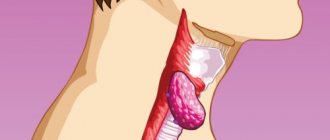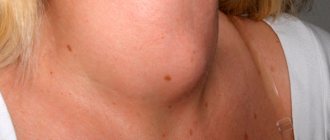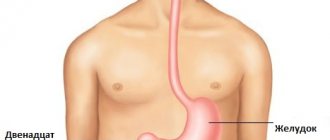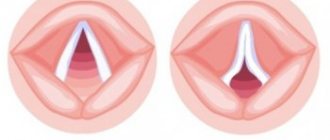Characteristic symptoms
The clinical picture of granulosa pharyngitis does not differ in the extent of symptoms.
Common signs of the disease include:
- sore throat and sore throat. These sensations intensify when swallowing food and water, as well as your own saliva;
- dry painful cough, accompanied by the discharge of a scanty amount of mucus;
- nausea and vomiting with severe irritation of the throat and root of the tongue during coughing;
- sensation of the presence of a foreign object in the laryngeal cavity.
- upon visual examination of the throat, the back wall of the throat looks loose and reddened.
An increase in temperature is usually not observed, but in the primary form, caused by a virus or bacteria entering the body, it can reach low-grade levels (up to 38 degrees).
Granular pharyngitis, accompanied by purulent tonsillitis, occurs against a background of high temperature, but in this situation it is difficult to make an adequate diagnosis due to the similarity of the symptoms of the two pathologies.
Acute form
Acute granulosa pharyngitis occurs as an independent disease, provoked by an attack of bacteria or viruses.
Penetrating into the tissue of the mucous membrane of the throat, especially with weakened immunity, when the body cannot independently stop the proliferation of microbial flora, the pathogen leads to the appearance of the first symptoms.
Initially, the patient feels a sore throat of mild intensity and complains of dry mucous membranes, itching and soreness.
If the acute onset of the disease is accompanied by a sharp rise in temperature, the person usually turns to an ENT doctor and the pathology can be cured in time. In the absence of hyperthermia, signs of the disease are often ignored because they do not cause significant discomfort.
The pathological process slowly progresses, epithelial tissues loosen and become thin with signs of atrophy.
At the initial stage of the disease, red granules are formed along the posterior laryngeal wall, which are swollen, clumped follicles.
They resemble millet grains in size; as inflammation progresses, the volume of the granules increases.
Also, the acute stage of the disease is manifested by dilation of blood vessels and increased activity of the glands. They produce viscous sputum, often containing purulent patches.
Patients describe their symptoms as follows:
- dry throat, constant feeling of thirst;
- discomfort in the throat, aggravated by coughing in attempts to clear the larynx of thick mucous exudate;
- the appearance of bad breath;
- difficulty swallowing;
- in the bacterial form of the primary disease, an increase in temperature, accompanied by signs of general intoxication (headaches and muscle pains, fever, chills);
Regional lymph nodes (under the lower jaw and behind the ears) react sharply to the inflammation process; upon palpation they are painful and enlarged in size.
If such symptoms occur, it is necessary to consult an ENT doctor and undergo diagnostics to eliminate the root cause of the disease and prevent it from becoming chronic.
Chronic stage
Chronicization of the process in 90% of cases occurs in the absence of adequate therapy at the acute stage of the disease.
Also provoking factors are an unhealthy lifestyle, reduced immunity against the background of recurrent nasopharyngeal infections.
The chronic form of granulosa pharyngitis occurs without an increase in temperature, its jumps are observed only during exacerbations.
Granulosa formations become voluminous, hypertrophy is accompanied by the release of large amounts of mucus and pus. Dryness and sore throat become the patient's constant companions.
Attempts to cough up purulent sputum result in bouts of vomiting; the patient is bothered by the feeling that something is stuck in the laryngeal cavity.
Over time, the timbre of the voice changes, it becomes hoarse, and hoarseness develops due to constant coughing and swelling of the mucous membrane. General health suffers only during periods of exacerbation, at which time the lymph nodes enlarge.
In the chronic form of the pathology, the lateral ridges and palatine arch are involved in the inflammatory process; all these areas are also covered with enlarged follicles, becoming loose and edematous.
Exacerbation of granulosa pharyngitis can begin against the background of diabetes mellitus, hypothyroidism and metabolic disorders.
If a patient has difficulty breathing due to the growth of polyps and adenoids in the sinus cavity, he is forced to breathe through his mouth, which only aggravates the clinical picture of the disease.
Causes of inflammation of the nasopharynx
The most common cause of inflammation of the nasopharynx is colds caused by hypothermia. Often the development of nasopharyngitis is observed against the background of reduced immunity, which can occur with certain infectious pathologies, for example, with measles or scarlet fever.
Another reason for this phenomenon is considered to be allergies. In this case, the inflammatory process occurs under the influence of a specific allergen and quickly subsides when contact with it is eliminated.
In addition, redness, swelling and pain in the mucous membrane can be caused by exposure to adverse factors such as dust, cigarette smoke, exhaust fumes, vapors of various irritants, etc.
Allergic inflammation of the nasopharynx
Symptoms of allergic inflammation of the nasopharynx are similar to the infectious form of the disease. The difference lies in the reasons that caused this reaction. For allergic inflammation, this is caused by exposure to allergens. Most often, the nose is the first to suffer upon contact with them, after which the pharynx is also involved in the process. However, in some cases, a reverse development of inflammation is possible - the pharynx is first affected, after which the inflammation spreads to the nasal cavity.
Treatment of this form of nasopharyngitis consists mainly of eliminating contact with the allergen; in addition, symptomatic therapy can be used.
Treatment of the chronic form in the acute stage
If a chronic disease has worsened, it is necessary to identify the type of pathogen that caused the infection.
Depending on the results of the analysis, medications are prescribed:
- Antibiotics – for bacterial etiology of the disease. Mainly penicillin groups (Augmentin, Flemoxin Solutab, Amoxiclav), macrolides (Azithromycin, Erythromycin, Sumamed). Cephalosporins are used when there is no effect from therapy with other groups of antibacterial drugs. Names: Cephalexin, Cefamed, Ceftriaxone.
- Antiviral - if the exacerbation is caused by a viral infection. The drugs Viferon, Interferon, Cycloferon, Acyclovir, Ganciclovir are prescribed. Taking them allows you to speed up the elimination of the virus and stimulate the body to independently fight the pathogen.
The patient is prescribed vitamin complexes enriched with zinc, selenium, groups A, B, E and C. During treatment, it is necessary to follow the diet described above, not drink alcohol and smoke less.
It is imperative to adhere to the drinking regime to eliminate signs of intoxication and thin the thick phlegm that accumulates in the throat.
For this purpose, they use poisons of chamomile, rose hips, viburnum, clean water, and fruit drinks made from non-acidic berries. At night you can drink warm milk with honey, or with a pinch of soda and a piece of butter.
Symptoms
The symptoms of granulosa pharyngitis will allow the otolaryngologist to determine the stage of development of pathological processes and also identify the affected area.
The disease is accompanied by the following clinical signs:
- pain and sore throat, aggravated by swallowing saliva or while eating;
- dry painful cough, which is accompanied by sputum production;
- nausea and vomiting due to severe irritation of the mucous membrane of the throat;
- a person is disturbed by the feeling of the presence of a foreign body in the throat;
- loose and reddened back of the throat.
In some situations, adults experience an increase in body temperature, and symptoms of intoxication also occur (fever, chills, body weakness, muscle pain and headache).
Considering the stage of granulosa pharyngitis, the patient develops the following clinical signs:
| Name | Symptoms |
| Acute granulosa pharyngitis |
|
| Chronic |
|
As pathological processes progress in the absence of high temperature, the tissues of the mucous membrane become thinner and loosen, and the first symptoms of atrophy appear.
What treatment is prescribed
In order to prescribe the correct treatment for tonsillitis or pharyngitis, it is important to clearly differentiate them from other diseases of the upper respiratory tract, as well as to identify the true cause of the development of inflammation. In both cases, complex therapy is provided, including symptomatic and etiotropic methods of treatment
In both cases, complex therapy is provided, including symptomatic and etiotropic treatment methods.
Therapy of acute tonsillitis
Therapeutic effects for acute tonsillitis are aimed primarily at alleviating symptoms and are based on local remedies:
- taking systemic antibiotics (Amoxicillin, Amoxicar);
- gargling with drugs with antibacterial and anti-inflammatory effects (Furacilin, Miramistin, Eludril, Rivanol);
- use of local antiseptic and painkillers (Falimint, Strepsils, Septolete);
- irrigation of the tonsils with antiseptics (Ingalipt, Kameton);
- antipyretic drugs to combat temperatures above 38.5°C (Paracetamol, Theraflu, Rinza, Panadol);
- treatment of tonsils with products containing higher temperature iodine (Lugol, Iodinol);
- immunomodulatory drugs (Anaferon, children are prescribed rectal suppositories Viferon, Genferon).
As an auxiliary treatment of acute tonsillitis, folk remedies are highly effective.
Gargling with decoctions of chamomile, sage leaves, mint, calendula and coltsfoot has also proven effective for tonsillitis.
Treatment of chronic tonsillitis
Treatment of chronic tonsillitis is as follows:
- washing the palatine tonsils with antiseptic solutions (Octenisept, Chlorhexidine);
- regular rinsing of the mouth with a copper-silver aqueous solution;
- use of local immunomodulators (Ribomunil);
- adding essential oils to solutions for inhalation and rinsing;
- physiotherapeutic procedures for the throat and lymph nodes (ultrasound, laser therapy, magnetic therapy, FEF);
- Daily sanitation of the mouth, nose and paranasal sinuses.
How is acute pharyngitis treated?
Therapy for acute pharyngitis does not involve the use of antibiotics unless a bacterial infection has occurred.
The standard treatment regimen for pharyngitis includes the following means and methods:
- gargling at least 6 times a day (Furacilin, solutions of soda and sea salt, decoctions of chamomile and calendula, mineral water);
- inhalation and throat irrigation with antiseptic solutions (Chlorophyllipt, Angilex);
- tablets and lozenges containing sulfonamides (Faringosept, Septifril);
- immunostimulating antiviral drugs (Viferon, Kagocel, Arbidol);
- plenty of warm drinks;
- dry compresses on the neck area;
- following a diet that excludes hard, spicy and fatty foods;
- regular wet cleaning of the patient's room.
Therapeutic measures against chronic pharyngitis
Treatment for chronic pharyngitis involves, first of all, eliminating the factors that caused the development of the disease; for this it is necessary to sanitize infectious foci in the oral cavity and nasopharynx, correct the deviated nasal septum, and treat the digestive system.
Taking antibiotics is indicated only in cases of hyperthermia and severe enlargement of lymph nodes. The most common and effective broad-spectrum drugs are Summed and Amoxiclav.
A mandatory method for pharyngitis is rinsing every half hour; for this you can use pharmaceutical antiseptics (Lugol, Hexoral), alkaline solutions or herbal decoctions.
Inflammation of the nasopharynx: treatment
When treating inflammation of the nasopharynx, you must first establish the cause of the disease, for which you need to consult a doctor. General recommendations include drinking plenty of warm fluids, avoiding heavy, hot and irritating foods, and bed rest. To remove accumulated mucus, rinsing the throat and nose is prescribed. Antibiotics are indicated only for infectious inflammation of the nasopharynx caused by pathogenic bacteria. In addition to pharmaceutical drugs, folk remedies are widely used for uncomplicated inflammation.
Antibiotics for inflammation of the nasopharynx
It is advisable that the course of treatment be prescribed by a doctor. A specialist will be able to find out the causes of inflammation and determine the necessary therapeutic measures. So, antibiotics can only be used if inflammation of the nasopharynx is bacterial. These medications can be prescribed in the form of sprays that treat the throat (Fuzafungin, Dexamethosone and others) and absorbable tablets (Ambazon, Antiangin and others). In the most severe and advanced cases, oral antibiotics may be prescribed for a certain period of time.
Treatment of inflammation of the nasopharynx with folk remedies
Folk remedies are widely used to treat inflammation of the nasopharynx. For example, to relieve inflammation and get rid of nasal congestion, you can drop a few drops of fresh beet juice into each nostril. It can also be used to soak cotton swabs, which are placed in the nasal passages for a while. Another way to help cope with a runny nose, ease breathing and relieve inflammation is to instill Kalanchoe juice into the nose.
To wash your nose and gargle, you can use an infusion or decoction of calendula or chamomile. An infusion of plantain or a herbal mixture consisting of leaves of coltsfoot, marshmallow, chamomile and licorice will help cope with a dry, painful cough.
Inflammation of the nasopharynx in children
In children, inflammation of the nasopharynx usually occurs in a more severe and acute form than in adults. Young patients are more likely to have a fever and develop complications such as pneumonia, bronchitis, croup and others. The greatest danger is posed by inflammatory diseases in infants, especially newborns. Their nasal congestion often leads to impaired sucking, fatigue, weight loss and decreased immunity. The baby may experience sleep disturbances, diarrhea, vomiting, and flatulence. Therefore, if signs of illness appear in young children, it is advisable to immediately go to the doctor or call him at home. Parents need to remember that the signs of inflammation of the nasopharynx in children are very similar to the symptoms of influenza, measles, diphtheria, scarlet fever and other dangerous diseases.
Similar articles:
Hypertrophy of the nasal mucosa
Nasal congestion without runny nose
How to treat nasal congestion
Mucus in the throat, causes
There is probably not a single person on earth who does not know the troubles associated with inflammation of the nasopharynx. Inflammation of the nasopharynx or nasopharyngitis, also called nasopharyngitis, is manifested by damage to the mucous membrane of the upper respiratory tract: the nose and throat (pharynx) - with the formation of a liquid or viscous secretion, accompanied by elevated body temperature.
Causes of appearance Clinical picture Treatment methods Features of therapy in children and pregnancy Traditional medicine Preventive measures
Most often, nasopharyngitis occurs due to infectious infection, but such inflammation can also be of an allergic or traumatic (mechanical) nature.
Rhinopharyngitis can be acute or chronic.
Acute - characterized by a rapid onset and develops mainly against the background of a viral infection, very rarely - bacterial.
Chronic nasopharyngitis, usually of a bacterial or fungal nature, is less pronounced and occurs as a complication after untreated acute inflammation of the nasopharynx or due to its frequent irritation, for example, from polluted air or smoking.
The chronic form of the disease is more difficult to cure, but if left untreated it can cause serious complications, including death.
Reasons for appearance
The most common cause of inflammation of the nasopharynx is hypothermia.
To do this, it is enough to drink cold water, stand in a draft, wet your feet in rainy weather, have a long conversation in the cold, etc.
People with weakened immune systems are primarily susceptible to this disease.
What do you know about sialadenitis? The proposed article, hidden under the link, describes in detail the causes, symptoms and treatment methods.
A runny nose with blood and why it occurs is written on this page.
The cause of nasopharyngitis can also be an allergy to wool, dust, flowers, or certain foods - such inflammation is called the allergic form of nasopharyngitis.
Rhinopharyngitis can appear after infection of the body with ARVI or influenza, which are transmitted from person to person through household means.
Viral diseases involve rhinoviruses, and bacterial diseases include staphylococci in the nose (treatment with chlorophyllipt), streptococci, pneumococci, meningococci and other microorganisms that almost everyone has in the nasopharynx in a non-pathogenic (non-disease-causing) form.
Clinical picture
In the case of infectious viral nasopharyngitis, the disease begins acutely and develops quickly; it is called acute nasopharyngitis.
At the beginning of the disease, symptoms such as dryness in the nasopharynx, tingling, sore throat, and sore throat are typical.
The sick person begins to sneeze, feels weak, and gets tired quickly.
Symptoms increase over several hours.
Usually, in the evening the temperature rises to subfebrile levels of 37.5°C–38.0°C, and the patient shudders.
In the case of influenza, the thermometer reading can reach 39–40 degrees. There is aching in the back, joints, muscles, pain in the back of the head. Find out about cheap antiviral agents, their benefits and contraindications.
Subsequently, the mucous membrane of the nasopharynx swells, nasal discharge becomes abundant and watery, tears flow from the eyes, the sense of smell and taste disappears, and a severe cough may occur.
Viruses multiply intensively, forcing the body’s immunity to turn on all its capabilities.
This stage of the disease is called catarrhal and usually lasts 2-3 days. Then the nasal discharge decreases, becomes thicker, the mucus from the throat is cleared well, the body copes with the disease and recovers.
If the immune system is weak or the body has not received adequate treatment, complications such as sinusitis, otitis media, bronchitis, pneumonia, or, even worse, meningitis may occur. Also, acute nasopharyngitis can become chronic.
What do you know about the treatment of swelling of the nasal mucosa in a child? Read about healing methods by clicking on the link.
About Acyclovir ointment for colds on the lips is written here.
On the page: written about cytomegaly and treatment of the disease.
Important: if symptoms worsen rather than improve within 3-4 days, call an ambulance. In this case, hospitalization is required.
Chronic nasopharyngitis is divided into two types:
hypertrophic, atrophic.
The hypertrophic type is expressed by a thickened mucous membrane of the nasopharynx; the patient feels as if he has a lump in his throat. A cough with thick sputum and a constant runny nose do not give rest.
The atrophic type is expressed by dryness in the nose, throat, hoarseness, and it becomes difficult to swallow.
The symptoms of allergic inflammation of the nasopharynx are similar to acute nasopharyngitis, with the exception of high temperature.
If you experience any of the above symptoms, it is necessary to consult a doctor for a correct diagnosis so that adequate treatment can begin to avoid serious complications.
Treatment methods
Important: these recommendations are for informational purposes only and in no case can be regarded as a guide to action.
Taking any medications is possible only as prescribed by a doctor. Incorrectly started treatment can aggravate the situation.
Drug therapy for inflammation of the nasopharynx is aimed at eliminating the pathogen and alleviating the symptoms of the disease.
For proper treatment of the disease, it is necessary to undergo tests and find out what nature of nasopharyngitis is observed in the patient at the moment. It can be viral, bacterial, allergic or vasomotor.
In most cases, it all starts with viral nasopharyngitis. Then it is necessary to take antiviral drugs, for example, such as Rimantadine, Ingavirin, Amiksin, Kagocel and others.
In case of a bacterial disease, these drugs will not help. We need medications that act on bacterial microflora: Amoxicillin, Tsifran, Ciprofloxacin and others.
Remember that antibacterial drugs (antibiotics) do not act against viruses, and antiviral drugs are powerless against bacteria .
If the inflammation is allergic in nature, then antihistamines are needed - Diazolin, Suprastin.
To relieve pain symptoms and relieve high fever, you can take paracetamol-containing medications:
Rinza, Theraflu, Ibuprofen.
To eliminate a runny nose, vasoconstrictors are suitable:
Nazivin, Pinosol.
The sick person requires bed rest and plenty of fluids.
The air in the room should be moist and warm.
If your nose is very stuffy, a saline solution (a teaspoon per liter of water) will help.
It must be instilled into the nose into each nostril in turn until you are able to blow your nose.
Important: you should not blow your nose too much, otherwise the infection may get into the ear canal or maxillary cavities, and this can lead to otitis media, sinusitis or meningitis.
To relieve inflammation in the throat, you can rinse it with a saline solution or a decoction of herbs such as:
sage, calendula, chamomile, eucalyptus.
The decoction is prepared in a water bath - a tablespoon of herbs per half liter of water. Rinse: 6-7 times a day. This will relieve inflammation and promote mucus removal.
Antiseptics in the form of sprays: “ Bioparox ”, “ Lugol-spray ”, and suckable tablets: “ Faryngosept ”, “ Grammidin ” - will also help relieve inflammation in the throat.
Features of therapy in children and pregnancy
For children under one year of age and pregnant women, the use of medications is allowed only under the supervision of a doctor and strictly in the dosages indicated by him. We have written in more detail about the treatment of ARVI in early pregnancy on another page.
Independent use of drugs for rhinopharyngitis or nasopharyngitis in children is absolutely unacceptable.
Only a doctor can assess the severity of the disease, weigh the benefits and harms of using medications and decide whether it is worth prescribing antiviral drugs for children under 1 year of age.
Important: if you are pregnant or your child is under one year old, never decide on your own about the use of medications. In these cases, only the doctor can make decisions.
In the situations described above, treatment of inflammation of the nasopharynx mainly comes down to freeing the nasal passages from mucus so that it is possible to breathe without difficulty. If pregnant women and children have difficulty breathing, it is recommended to rinse their nose with saline solution.
The solution must be instilled into each hole until an adult can blow his nose, and a child’s nose can be cleared of mucus using an aspirator or cotton swabs.
If the mucous membrane is too swollen and mechanical cleaning does not help, the doctor may decide to use vasoconstrictor drugs.
If the situation is too severe, the doctor may prescribe antibiotics or antiviral drugs, as well as antipyretics.
ethnoscience
The traditional method of treatment is considered the safest, since its use is based on only natural ingredients.
But pregnant women need to remember that not every herb can be drunk and not every method can be used. Therefore, before using this or that folk remedy, they always need to consult a doctor.
For a sore throat, traditional medicine recommends gargling with herbal infusions:
7 parts oak bark, 3 parts cordate linden flowers; 2 parts marshmallow root, 2 parts chamomile, part calamus, part sweet clover; part sage leaves, part St. John's wort herb, 2 parts marshmallow root, 2 parts oregano, part peppermint leaves.
The infusions are prepared in a water bath for 15 minutes at the rate of 1 tablespoon per glass of boiling water. Then the broth is infused for 30 minutes and filtered. Gargle 4-5 times a day.
For dry cough:
Pour one tablespoon of dry crushed plantain leaves into a glass of boiling water, leave for 2 hours, strain. Drink a tablespoon 5-6 times a day half an hour before meals.
For a runny nose:
Place freshly squeezed juice from the leaves of Kalanchoe pinnate into each nostril, 6-7 drops. Instead of Kalanchoe, you can use aloe vera juice, diluting it with sea buckthorn oil or honey 1:1. Preventive measures
Hardening takes first place in the prevention of colds. It will strengthen the immune system and adapt the body to sudden temperature changes. You need to start hardening from early childhood.
Don’t forget to ventilate living spaces and do general cleaning regularly. Wash your hands often with soap. During epidemics, wear protective masks.
Keep your feet warm, wear woolen socks and genuine leather shoes during the cold season.
To get sick less often, go out into nature more often. Do morning exercises, enjoy walks, eat a varied and nutritious diet, eating plenty of vegetables and fruits.
Get your flu shots up to date.
By following these simple recommendations, you will protect your body from infection, and inflammation of the nasopharynx will bypass you!
You will learn about the treatment of inflammation of the paranasal sinuses by watching the video.
Inflammation of the nasopharynx is a frequently diagnosed disease that affects both children and adults equally (this disease is also called nasopharyngitis). The inflammatory process affects the mucous membrane of the throat and nose, promoting the active formation of viscous mucus. This is often accompanied by elevated temperature. The symptoms of nasopharyngitis are similar to pharyngitis and rhinitis. In most cases, it develops against their background due to improper treatment.
Chronic inflammation of the posterior pharyngeal wall
The symptoms of chronic pharyngitis differ significantly from the acute form. With chronic pharyngitis, there is no sharp increase in temperature. In general, the person’s condition is relatively better than in the acute form of the disease.
Patients complain of pain in the throat, a feeling of soreness and a “lump” in the back of the throat. These factors cause an unbearable cough that constantly worries a person. This symptom is typical only for chronic inflammation of the posterior pharyngeal wall.
Mucus that accumulates on the wall of the pharynx, especially at the back, forces the patient to constantly swallow. While swallowing, a person complains of unpleasant pain. This deteriorates the quality of life and prevents a person from sleeping normally. At the same time, appetite is significantly reduced. Therefore, if the throat is constantly inflamed, it may become chronic.
There are several forms of chronic pharyngitis:
- Atrophic.
- Granular.
- Hypertrophic.
The mucous membrane is slightly thinned in the atrophic form. There is a sharp dryness; in some cases, the mucus that was on the wall gradually begins to dry out. Upon examination, the doctor notes a pronounced network of capillaries on the wall.
With hypertrophic chronic inflammation of the posterior pharyngeal wall, excessive formation of lymphoid tissue is observed. The lateral tubopharyngeal ridges, which are localized behind the palatine arches, increase in size. In addition to these pathological manifestations, edema with severe hyperemia also occurs.
In most cases, chronic pharyngitis does not occur as an independent disease. Concomitant diseases are observed, for example, chronic atrophic gastritis with various forms of pancreatitis and cholecystitis. This is due to the fact that there is a reflux of contents from the stomach, which begins to affect the mucous membrane of the pharynx, disrupting trophism and leading to dysfunction. This process occurs at night, during sleep. Bad habits, such as smoking tobacco, lead to the death of mucosal cells. Therefore, you need to get rid of the bad habit.
Causes of chronic pharyngitis
There are factors that lead to chronic inflammation of the posterior pharyngeal wall. The most important of them are:
- The specific structure of the anatomical parts of the mucous membrane of the pharynx, larynx and digestive system, in particular the esophagus and stomach.
- Constant damage to the back wall of the pharynx by various external factors (polluted air, dust particles, etc.).
- Forced breathing through the mouth due to the inability to breathe through the nose.
- Drinking large amounts of alcohol and smoking cigarettes.
- Exposure to various allergens.
- Diseases of the thyroid gland and other endocrine pathologies.
- Lack of vitamins, particularly vitamin A.
- Pathology of the heart, kidneys.
- Diabetes insipidus and diabetes mellitus.
It is important that pharyngitis often occurs as a result of breathing through the nose. This phenomenon is observed as a result of disease of the nasal cavity. Frequent use of vasoconstrictor nasal drops has a detrimental effect on the back of the throat due to its irritating effect. The negative feeling is caused by a phenomenon in which some of the mucus draining from the nasal cavity ends up in the throat. Constant drainage may be manifested by wheezing and whistling. This clinical sign is characteristic of children, so it is necessary to differentiate it from a disease such as bronchitis.
What is granulosa pharyngitis, causes of development
Pharyngitis is an inflammation of the throat, which is accompanied by pronounced damage to the mucous membrane of the pharynx and lymph nodes. The granular form is characterized by the appearance on the back wall of the pharynx of certain granules, consisting of elements of overgrown lymphoid tissue, leukocytes, dead cells, and bacteria. The size of small nodules is 1-2 mm. Larger granules can cause irritation of nerve endings, which leads to an exacerbation of the disease.
There are two forms of granulosa pharyngitis: acute and chronic. The latter, as a rule, develops as a result of untimely or incorrect treatment of the former.
Causes of chronic granulosa pharyngitis
The main reasons for the development of hypertrophic pharyngitis are genetic predisposition and negative environmental influences. Therefore, if you have relatives with a history of such a disease, you need to be more attentive to your health, especially to diseases of the pharynx.
In addition, pathology can be caused by the following factors:
- tendency to allergic reactions;
- penetration of acidic gastric contents into the pharynx through the esophagus (this phenomenon is observed with the gastroesophageal reflex);
- regular irritation of the pharyngeal mucosa by aggressive substances (sour, salty, spicy foods, tobacco smoke, alcohol);
- sluggish pathologies of the nasal sinuses;
- damage to the nasopharynx by various fungi, viruses and bacteria that provoke the development of inflammatory processes;
- frequent and prolonged stay in rooms with low humidity;
- damage to the nasal septum or abnormal structure of the nasal cavity;
- complicated sinusitis, caries, rhinitis, tonsillitis;
- regular contact of the respiratory mucosa with toxic dust and gases.
Often acute pharyngitis takes the form of granulosa. This happens when treatment does not give the desired effect. The presence of previous diseases of the nasopharynx increases the likelihood of transition to the granulosa form.
Chronic and hypertrophic granulosa pharyngitis: photos, symptoms
The symptoms of granulosa pharyngitis are quite specific and are characterized by the following signs:
- paroxysmal cough;
- a feeling of sore throat that is almost constantly present;
- the presence of viscous sputum in the throat in the morning, when you try to cough it up, nausea and vomiting appear;
- slight pain when swallowing.
When diagnosing the disease, symptoms such as swelling and redness of the tissues of the larynx, their obvious thickening, as well as the appearance of granules and follicles on the surface of the pharynx are observed.
If the course of hypertrophic granulosa pharyngitis is accompanied by an infection, the symptoms may resemble an acute purulent sore throat with aching joints and high fever. Sometimes the symptoms of the disease are mild and therefore go unnoticed. Meanwhile, the development of the pathology continues and, in the absence of treatment, the disease enters a complicated stage.
When the first signs of the disease appear, you should seek qualified help as soon as possible for proper diagnosis and treatment. This can only be done by an otolaryngologist.
Symptomatic remedies
A mandatory item is local treatment of the throat, it is carried out as follows:
- Irrigation with sprays with antiseptic and analgesic effects. The drugs used are Hexoral, Tantum Verde, Lugolit, Miramistin, Bioparox, Kameton, Ingalipt, Hexaliz.
- Gargling with solutions of Chlorhexidine, Chlorophyllipt, Miramistin, saline solution, a solution of salt and soda with the addition of a couple of drops of iodine. Also suitable for rinsing are decoctions of medicinal herbs with anti-inflammatory and healing properties - chamomile, coltsfoot, eucalyptus, mint, lavender.
- Lubricating the affected areas with Lugol's solutions, methylene blue (if a fungal infection is attached), and sea buckthorn oil. To relieve swelling, the back wall is treated with a glycerin-based tannin solution, Protargol, Collargol, and a 1-2% silver nitrate solution. This dries out the epithelium; the preparations can be used for irrigation. A solution of vitamin E in nut oil, applied daily to the mucous membrane, helps moisturize and heal it.
- Cauterization of the mucous membrane with a 10-30% solution of silver nitrate or trichloroacetic acid (carried out in the ENT doctor’s office so as not to further damage the throat).
- Inhalations over steam using saline solution, herbal decoctions (eucalyptus, peach, tea tree, mint, sea buckthorn) and using a nebulizer using corticosteroids (Hydrocortisone only as prescribed by a doctor), thinning and expectorants (Acetylcysteine, Ambrobene, Lazolvan, Bromhexine) .
In order for the granules on the surface of the larynx to dissolve faster, injections of Aloe, ATP and Solcoseryl, and B vitamins are prescribed.
Also, for this, the doctor recommends taking a course of physiotherapy - phonophoresis with propolis, UHF, mud applications, electrophoresis with a solution of potassium iodide on the area under the lower jaw.
Diagnosis and treatment
Inflammation of the nasopharynx, treatment of which always begins with an examination, involves examining the patient, collecting an anamnesis (questioning the patient) and using the method of nasopharyngoscopy. This procedure allows you to analyze the current state of the nasopharyngeal mucosa and determine the amount of mucus present.
To check the presence/absence of chronic nasopharyngitis, an additional X-ray examination is prescribed, as well as a computed tomography scan of the nasopharynx.
The nasopharynx, inflammation of which is diagnosed quite often, is treated under the guidance of a doctor. The main task is to reduce the intensity of symptoms and eliminate the inflammatory process. Be sure to observe bed rest. In order not to provoke swelling, it is recommended to exclude cold and hot foods, excessively spicy and sour dishes from the diet. Treatment of rhinopharyngitis involves the following:
It is necessary to regularly rinse the nose with saline solution. It is sold in any pharmacy, and if desired, such a solution can be easily prepared at home. For this we will need regular kitchen salt (although iodized salt would still be preferable). You need to dissolve a spoonful of salt in one liter of warm (pre-boiled) water and drop the mixture into your nose every three hours. Rinsing quickly relieves congestion and is well suited even for the youngest children. Sprays and drops for constricting blood vessels last from 8 to 12 hours, but before using such drugs you should consult your doctor. The dosage for adults and children will be different. The disadvantage of such drugs is the emergence of dependence. Therefore, their use is limited, as a rule, to 7 days. As for the allergic form of nasopharyngitis, it is treated with antihistamines. To soothe the pharyngeal mucosa and relieve inflammation, it is recommended to use local antiseptic drugs (lozenges, tablets). But before that you need to clear the mucous membrane of sputum. To speed up the removal of mucus, try a decoction based on medicinal herbs. Pour one tablespoon of sage into 500 ml of regular hot water and place in a water bath. The result is an infusion that should be used to gargle at least 5 times a day. In addition to sage, eucalyptus, coltsfoot, and licorice root help quickly get rid of mucus. Remedies from the arsenal of traditional medicine are also well suited for relieving nasal congestion. You will need to prepare beet juice (an alternative would be Kalanchoe juice). Drip it into both nostrils, 2 drops at a time, and you will notice how quickly normal breathing through the nose is restored. Drug treatment is used to relieve swelling. Solutions of Lugol, Yox and some others have proven themselves well. Physiotherapy (heating and UHF) will help cope with the chronic form of the disease.
Recognizing granulosa pharyngitis in a child: treatment and prevention according to the rules
Granulosa pharyngitis refers to inflammation of the larynx, in which specific nodules and tubercles appear on the surface of the throat. The second name of the pathology is hypertrophic pharyngitis. In this article we will talk about the symptoms of the disease and approaches to its treatment in children.
What it is
Granular pharyngitis in children cannot be completely cured. At certain moments, the disease either worsens or goes into remission. In other words, granulosa pharyngitis as an independent pathology of the nasopharynx flows from an acute to a chronic form. Treatment of this type of pharyngitis takes a long time.
Photo of a child's throat:
Causes
The hypertrophied form of the disease is a complication of diseases of the upper respiratory tract. The following factors can provoke such pharyngitis:
- weakened immunity of the child due to untreated ARVI;
- ignoring symptoms;
- discontinuation of antiviral or antibacterial drugs;
- chronic infectious diseases;
- child hypothermia;
- damage by viruses and bacteria;
- congenital pathologies of the respiratory tract;
- hereditary diseases;
- allergic reactions.
Diagnostics
If there is any discomfort in the throat area of the child, you should immediately contact your local pediatrician.
Only a specialist, after a thorough examination and study of the medical history, will make a preliminary diagnosis and give a referral for examination.
Diagnosis is extremely important for differentiating granulosa pharyngitis from acute tonsillitis and other diseases with similar symptoms.
The research includes a number of stages:
- pharyngoscopy – external examination of the pharynx;
- bacteriological throat swab for culture;
- direct or indirect laryngoscopy for suspected chronic laryngitis;
- a general blood test to identify the inflammatory process.
How to treat
If granulosa pharyngitis is diagnosed in a child, treatment will include a set of measures aimed at eliminating its main symptoms and the root cause of the disease.
Typically, therapy includes:
- inhalations,
- taking special medications,
- traditional medicine recipes as concomitant treatment.
| Antiviral, anti-inflammatory | Suppositories Viferon, Remantadine, Orvirem syrup |
| Lollipops and lozenges (not recommended for children under three years of age) | Strepsils, Faringosept, Lizobakt |
| Sprays for irrigating the pharynx | Lugol, TantumVerde, Miramistin |
| Immunostimulants | Grippferon, Anaferon, Ergoferon |
Inhalations with saline solution play an important role in treatment. They are allowed for children of the first year of life. Older children can gargle with herbal decoctions on their own.
It is necessary to use traditional medicine recipes with extreme caution, since often the components can provoke severe allergies. The child needs to drink a lot
These can be a variety of fruit drinks, compotes, herbal decoctions
The child needs to drink a lot. These can be a variety of fruit drinks, compotes, and herbal decoctions.
Traditional medicine suggests using a decoction of blueberries, which will help quickly remove the infection from the body and prevent complications from developing.
A sick child must be provided with:
- peace,
- moist fresh air,
- appropriate nutrition and plenty of fluids.
When treating hypertrophied pharyngitis, the following actions should be avoided:
- Steam your feet and do steam inhalations at high temperatures.
- Abuse treatment with alcohol solutions and soda rinses.
- Apply warm compresses to the throat.
Prevention
It is impossible to cure granulosa pharyngitis completely, but you can extend the period of calm. To do this, parents need to follow a number of preventive measures:
- Constant wet cleaning and air humidity control. Sleeping in a dry room for a child with a predisposition to chronic hypertrophied pharyngitis can be dangerous.
- Protect your baby from harmful factors. For example, tobacco smoke or dust.
- Timely and complete treatment of any disease.
- Hardening and strengthening the immune system in general.
Conclusion
- Granular pharyngitis is a complication of acute pharyngitis and requires long-term, targeted treatment under medical supervision.
- Symptoms of this type of pharyngitis may be similar to those of a sore throat or other disease associated with inflammation of the larynx. To differentiate the diagnosis, pharyngoscopy is performed, and laboratory tests are also prescribed.
- Treatment of children is complex and involves both taking medications and following a diet, drinking regimen, and air humidity.
Useful tips
Hardening is of great importance for prevention. Regular contrast showers and rubdowns help strengthen the body's immune forces. In addition, it helps to adapt to sudden temperature changes. If possible, hardening should begin in early childhood and continue into adulthood.
Regularly ventilate living rooms, perform wet cleaning, and do not forget to wash your hands with soap often. Don't neglect protective masks: they will help keep you healthy during seasonal cold and flu epidemics. Always dress appropriately for the season and weather. Walk outdoors for at least 45 minutes every day.
Morning exercises and good nutrition also have a good effect on the body. Give up processed foods, eat natural foods, and add vegetables and fruits to your diet. Don't forget to get preventative flu shots. All these simple tips will help protect against inflammation of the nasal and pharyngeal mucosa.
If you notice the first signs of nasopharyngitis, do not let the disease take its course and do not self-medicate. If treated incorrectly, this disease quickly transforms from an acute form to a chronic form, which is very difficult to cure. When you have a sore throat, nasal congestion and other accompanying symptoms of nasopharyngitis, consult a doctor. He will help determine the cause of inflammation and create the optimal treatment strategy.
Symptoms of granulosa pharyngitis
Symptoms of granulosa pharyngitis include a feeling of discomfort in the throat. It occurs due to chronic inflammation of the mucous membrane, which leads to loosening, thickening and proliferation of epithelial tissues. Always with granulosa pharyngitis, granules (nodules) are formed on the back wall of the throat, which are represented by swollen follicles that have merged with each other. The size of these elevations is similar to the size of millet grains; they are dark red in color.
In addition, discomfort in the throat is explained by the expansion of lymphatic and blood vessels, increased work of secretory glands, producing viscous thick sputum, sometimes containing impurities of pus.
Complaints of patients with granulosa pharyngitis are as follows:
- Dryness, rawness, burning and sore throat.
- Periodic bouts of severe coughing and constant coughing associated with discomfort in the throat.
- Accumulation of thick purulent sputum, which is very difficult to separate. In this regard, attempts to cough may be accompanied by a feeling of nausea and vomiting.
- An unpleasant odor emanates from the patient's mouth.
- There is a constant sensation of a foreign body in the throat.
- The pain is most often mild and intensifies when taking an empty sip (swallowing saliva). Eating food and drinking liquids usually does not cause significant discomfort, although swallowing may sometimes be difficult.
- Over time, the timbre of the patient's voice changes, becoming hoarse. Hoarseness develops due to constant coughing and swelling.
- Body temperature remains within normal limits, however, during periods of exacerbation of the disease it can rise to high levels. In this case, headache and muscle pain develop, the cough intensifies, and the symptoms of intoxication increase.
- The general well-being of a person suffers, and performance decreases.
- There may be an increase in regional lymph nodes that respond to the inflammation process. On palpation their pain is noted.
Symptoms
Inflammation of the nasopharynx can occur in acute or chronic form. Acute nasopharyngitis develops very quickly due to viral infection (less commonly, the pathogen can be bacterial). The chronic form of the disease is characterized by less severe symptoms. The disease is mainly caused by fungal or bacterial pathogens and acts as a complication of the acute form. Chronic inflammation of the nasopharynx is more difficult to treat than acute inflammation.
A runny nose, pain when swallowing and other manifestations of a cold are known, perhaps, to everyone without exception. Inflammation of the nasopharynx is accompanied by similar symptoms. Patients quickly develop the following signs of the disease:
nasal congestion; rhinitis; regular headache; sore throat, discomfort in the throat and so on.
In addition to the above symptoms, fever is diagnosed. There is general weakness, the voice (due to nasal congestion) becomes nasal. Often, signs of nasopharyngitis are confused with manifestations of tonsillitis. In this case, acute pain in the throat also occurs, and the tonsils may become inflamed. Therefore, only a doctor should make an accurate diagnosis, otherwise there is a high probability of inappropriate therapy.
Children (especially in preschool age) suffer this disease more severely than adults. Due to the weakness of the immune system, the infection penetrates the body with lightning speed. At the same time, the body temperature jumps to subfebrile values (up to 39 degrees). It often causes cramps and disruption of the stomach.
Treatment of granulosa pharyngitis
Conservative treatment of granulosa pharyngitis comes down to eliminating the inflammation itself, as well as eliminating the causes that caused it
It is important to stop smoking, drinking alcoholic beverages, and eating foods that irritate the mucous membrane of the throat. To do this, exclude all spicy, salty, pickled dishes.
Food and drinks should not be too hot or too cold.
Without fail, the patient needs to get rid of dental caries, all inflammatory processes in the nasopharynx, and normalize nasal breathing. Antihistamines are prescribed if there is a history of allergic reactions. These can be drugs such as Diazolin, Suprastin, Zyrtec, Zodak, etc. In addition to eliminating allergic reactions, taking them can reduce swelling of the throat mucosa.
To eliminate the bacterial flora, if one has been identified, systemic antibiotics may be prescribed. Drugs are selected taking into account the sensitivity of microorganisms to them. Most often, antibiotics from the penicillin group are prescribed (Augmentin, Ampicillin, etc.)
For local treatment of the throat, absorbable tablets (Strepsils, Faringosept, Hexaliz, Lizobakt, Septolete) and antiseptic sprays, for example, Hexoral, Miramistin, Octenisept, etc. are used. It is important to gargle regularly, which allows you to wash off the existing mucus. An isotonic solution of sodium chloride at 1% concentration is well suited for this.
You can add 5 drops of an alcohol solution of iodine of 5% concentration to 200 ml of solution. If you gargle with this composition, you can reduce the symptoms of the disease and relieve irritation from the mucous membrane. You can also use Tantum Verde solution for this purpose. It is possible to carry out oil inhalations using eucalyptus, lavender, sage and pine oils. These procedures are aimed at moisturizing and antiseptic treatment of the throat mucosa and help slow down the processes of tissue atrophy. You can also use a device called a nebulizer for inhalation. With its help, ordinary alkaline mineral water or saline solution moisturizes the mucous membrane of the throat. Means for local treatment of the throat are: Burov's liquid, resorcinol solution, alcohol-based propolis solution, eucalyptus tincture, protargol and collargol solution, tannin with glycerin, zinc sulfate solution, etc. Cauterization of granules with chromic or trichloroacetic acid is carried out when they grow significantly . The procedure is performed under local anesthesia. Silver nitrate can also be used for cauterization. Cryotherapy, laser treatment of granules, radio wave shading of the back wall of the throat are performed with severe tissue hypertrophy.
If treatment is carried out in full, all foci of infection are eliminated, professional and household hazards are eliminated, then most often in 14-21 weeks it is possible to achieve regression of granulosa pharyngitis.
Author of the article:
Education: In 2009, received a diploma in General Medicine from Petrozavodsk State University. After completing an internship at the Murmansk Regional Clinical Hospital, he received a diploma in the specialty “Otorhinolaryngology” (2010)
Ask your question
Features of therapy for children and pregnant women
The nasopharynx can become inflamed in babies and pregnant women. Therapy in this case will be slightly different. It should be carried out only under the supervision of doctors who carefully select medications, determine the optimal dosage, and determine the advisability of using antiviral drugs.
The priority goal of treatment is to clear the airways of mucus and restore normal nasal breathing. To do this, it is recommended to use folk remedies, but only with the permission of the attending physician. Not all medicinal herbs can be used to treat nasopharyngitis in pregnant women, as well as in children under one year of age. Rinses based on the following herbal infusions have proven themselves to be effective:
3 parts linden flowers and 7 parts oak bark; 1 part calamus and sweet clover, 2 parts field chamomile and 2 parts marshmallow root; 1 part sage leaves, 1 part St. John's wort and peppermint, 2 parts each oregano and marshmallow root.
All the herbs described above are used to prepare infusions in a water bath (infuse for 15 minutes is enough). For 200 ml of hot water, one tablespoon of herbs is required.
A common accompanying symptom of nasopharyngitis is a dry cough. A decoction based on crushed plantain leaves will help you get rid of it quickly. One tablespoon of leaves should be poured with a glass of boiling water and left for at least 2 hours. After this, the broth is filtered and taken orally, one tablespoon at a time, 30 minutes before meals (no more than 6 times a day).
Predisposing factors
If the primary form of the disease can be diagnosed and cured in time by stopping the pathogen and treating the existing source of infection, then chronic granulosa pharyngitis occurs when indirect factors are added:
- latent carriage of staphylococcus, streptococcus, enterococcus;
- a sharp decrease in the body’s immune defense due to atrophy of the laryngeal mucosa and a decrease in the amount of secretion produced;
- the predominance of carbohydrates, carbonated drinks, spicy, fatty, salty foods in the diet;
- consumption of alcohol and tobacco products (this also includes passive smoking);
- living and working in unfavorable environmental conditions, when the air is polluted with dust, exhaust gases, and chemical waste;
- thermal and chemical burns of the larynx resulting from inhalation of hot steam, icy air, chemical vapors, such as chlorine or ammonia;
- allergic predisposition and the presence of autoimmune diseases.
Doctors came to the conclusion that the hereditary factor also influences the development of granulosa pharyngitis in acute and chronic forms, based on medical statistics.
Often, a similar diagnosis is made to several family members at once, or the disease is recorded in people whose parents or grandparents suffered from the pathology.









